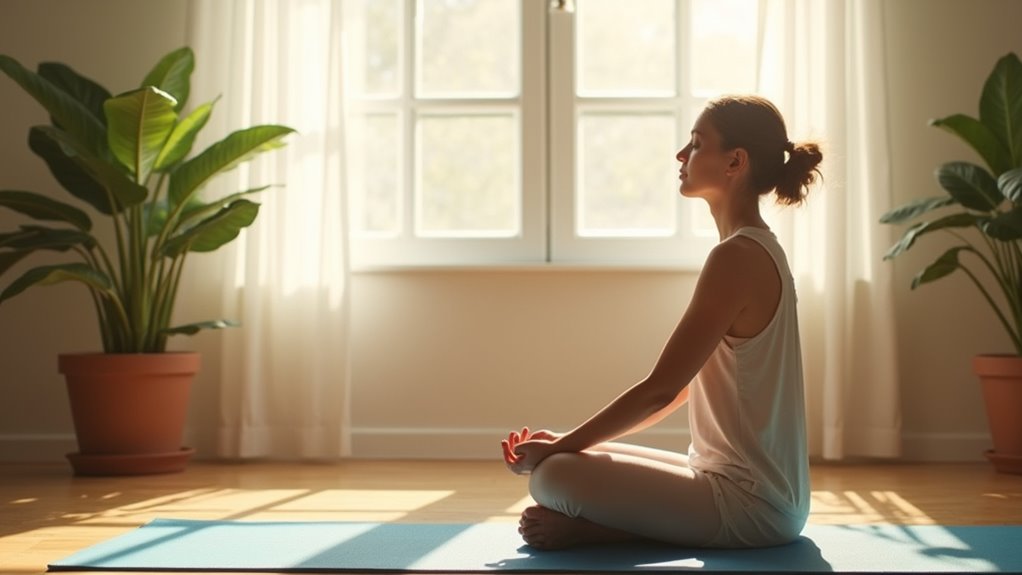On May 12, you might find it beneficial to explore deep breathing exercises as a practical approach to managing anxiety. These techniques can help you tap into your body’s natural relaxation response. By understanding how deep breathing works, you can learn to navigate your anxiety more effectively. But what specific exercises should you consider, and how can they improve your overall well-being? Let’s uncover the answers together.
Understanding the Connection Between Deep Breathing and Anxiety

When you’re feeling anxious, it’s essential to recognize how deep breathing can help you regain control. By activating your parasympathetic nervous system, deep breathing counters the “fight or flight” response, sending calming signals to your brain.
When you focus on slow, controlled exhalations, you increase vagal tone, promoting relaxation. This practice can lower your heart rate and blood pressure, while enhancing oxygen flow to your brain for clearer thinking. Additionally, as you engage in deep breathing, you address physical symptoms of anxiety directly, further supporting your ability to relax.
As you consciously regulate your breath, you can also balance gases disrupted during stress-induced hyperventilation. Ultimately, deep breathing not only reduces physical tension but also alleviates anxiety symptoms, helping you reclaim a sense of calm and control in stressful situations.
How Deep Breathing Exercises Work

Deep breathing exercises work by engaging your body’s natural mechanisms for relaxation and stress reduction.
When you practice deep breathing, you activate the parasympathetic nervous system, promoting a sense of calm that counteracts the overactive “fight or flight” response. This shift helps lower stress hormones like cortisol and reduces muscle tension. As you breathe deeply, you stimulate the vagus nerve, which relays messages between your brain and organs, enhancing relaxation. Additionally, deep breathing improves oxygen exchange and can lower your heart rate and blood pressure. Furthermore, incorporating deep and slow breathing into your routine can significantly enhance your mental well-being.
Types of Deep Breathing Exercises to Try

Many effective deep breathing exercises can help you manage anxiety and promote relaxation.
One popular method is diaphragmatic breathing, where you engage your diaphragm by lying down or sitting comfortably, inhaling through your nose, and feeling your belly rise. This technique is particularly beneficial as it strengthens the diaphragm, which is the main muscle responsible for breathing.
Pursed-lip breathing, another technique, involves inhaling through your nose and exhaling slowly through pursed lips to slow your breathing pace.
Box breathing, or four-square breathing, consists of inhaling, holding, exhaling, and holding again for equal counts.
Alternate nostril breathing helps balance your energy by alternating nostrils during inhalation and exhalation.
Lastly, the 4-7-8 technique combines specific ratios of inhalation, breath retention, and exhalation to reduce anxiety and aid sleep.
Try these exercises to find what works best for you.
Practicing Deep Breathing Effectively

To practice deep breathing effectively, it’s essential to create an environment that promotes relaxation and focus.
Find a comfortable, quiet place—whether lying down or sitting in a supportive chair. Wear loose clothing and aim to practice when your stomach’s relatively empty. Start by closing your eyes and releasing tension, bringing awareness to your natural breath. It’s important to remember that the brain may misinterpret stressors, which can lead to unnecessary stress responses.
Focus on diaphragmatic breathing; place one hand on your belly and the other on your chest. Inhale slowly through your nose, allowing your belly to rise, while your chest remains still. Exhale gently through your mouth or nose. Keep a steady rhythm, ideally 6-8 breaths per minute. Concentrate on your breath and notice how your body feels throughout the exercise.
Benefits of Deep Breathing for Anxiety Management

While anxiety can feel overwhelming, incorporating deep breathing exercises into your routine offers significant benefits for managing stress.
These exercises activate your parasympathetic nervous system, promoting a calming “rest and digest” response. You’ll find that deep breathing lowers your heart rate and blood pressure, reducing those anxious feelings. Additionally, longer out-breaths are particularly effective in reducing emotional arousal during these exercises.
It also improves oxygen exchange and can lower stress hormones like cortisol. Furthermore, deep breathing sends calming signals to your brain, helping manage panic attacks and enhancing your mood.
You’ll gain improved focus and clear thinking as oxygen flows to your brain. Plus, it’s easy to learn and can be practiced anywhere, providing both immediate relief and long-term resilience against stress.
Key Considerations and Research Findings on Deep Breathing Techniques

Incorporating deep breathing techniques into your anxiety management routine isn’t just about the immediate calming effects; it’s also important to understand the underlying physiological mechanisms and research findings that support their use.
Deep breathing activates your parasympathetic nervous system, promoting relaxation and reducing stress. It synchronizes your cardiovascular and respiratory systems, enhancing heart rate variability and cognitive performance through increased alpha wave activity. Deep breathing techniques have been empirically shown to improve symptoms of anxiety and depressive symptoms, making them a valuable tool in mental health management.
Research shows that diaphragmatic breathing can improve pulmonary function and decrease stress levels. However, be mindful of factors like your clothing, environment, and timing of practice.
While studies support deep breathing’s benefits, limitations exist, including variations in methodologies, underscoring the need for further robust research. Always consult a healthcare professional if you have respiratory conditions.
Conclusion
Incorporating deep breathing exercises into your daily routine can significantly help manage anxiety. By understanding how these techniques work and practicing them regularly, you can foster relaxation and improve your overall well-being. Remember to create a calm environment and choose the methods that resonate with you. With consistent practice, you’ll find that deep breathing not only alleviates stress but also enhances your mental clarity, making it a valuable tool for navigating life’s challenges.


